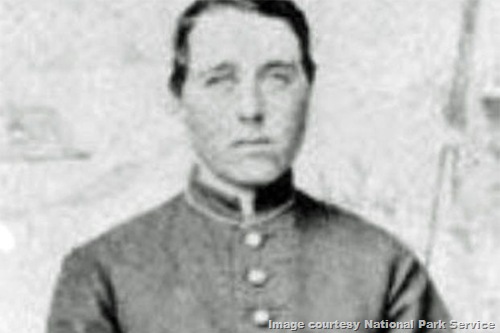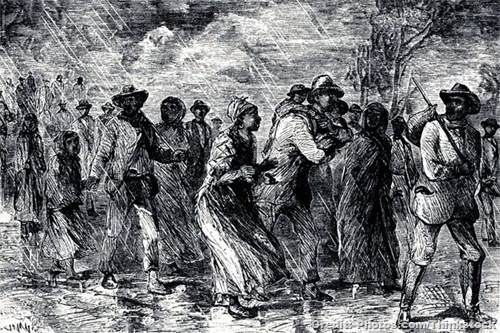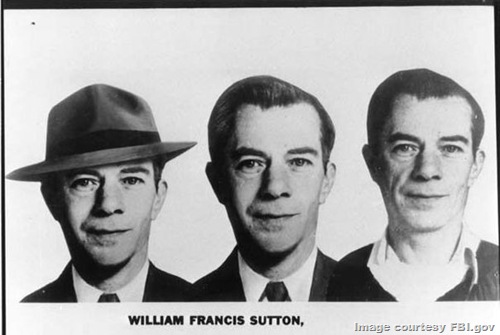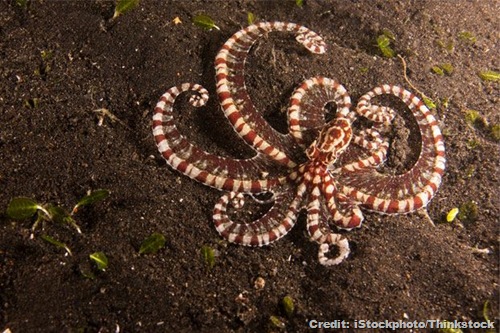
We're not talking about one of those laughable get-ups that celebs don when they want to go incognito. Nope, we're talking elaborate disguises - from operatic to scientific.
In comic books, superheroes make disguise look easy. They successfully hide in plain sight even when their costumes aren't clever or, in some cases, even concealing. Seriously, didn't anyone in Metropolis ever think that Superman looked a bit like the tall, handsome journalist hiding conspicuously behind the glasses and self-deprecation?
In real life, disguises are much more difficult to pull off. Just ask any A-lister who's tried to escape the paparazzi by donning a baseball cap and sunglasses. Not only does this rarely work - it usually results in a hideously ugly photograph on the cover of a celebrity mag.
You're looking at one of the more famous disguises that history has to offer: the Boston
Tea Party protesters who disguised themselves as Native Americans before dumping all
that tea.
Which is why disguises that actually conceal their owners are so impressive. Take the Boston Tea Party. Do we relish this American legend because a bunch of Massachusetts colonists tried to turn Boston Harbour into the world's biggest teapot? Sure, but there's also the fact that the colonists disguised themselves as Mohawk Indians before boarding the British tea ships and dumping 342 chests of tea overboard. They were clever and defiant - and they got away with it.
History is filled with similar connoisseurs of camouflage, and we have an entire list to prove it. Let's start with the granddaddy of all disguises - the horse that concealed an army that conquered an overconfident enemy.
10. Trojan Horse
So now we know: If a giant, wooden horse knocks at your door, probably best to pretend
you aren't home.
Everyone knows the story of the Trojan horse. The Greeks hid a small force of their warriors in the belly of a great wooden horse. Then they wheeled the horse to the gates of Troy and said, "Yo, dudes, we give up. Before we take off, please accept this noble steed as our gift to you." Then the Greeks boarded their ships and sailed off.
The Trojans should have been suspicious (heck, even the Trojan priest Laocoön warned about Greeks bearing gifts), but instead they opened the gates, pushed the horse inside and proceeded to party like it was 1999. Meanwhile, the Greek fleet was hiding out at a neighbouring island, waiting patiently. In the middle of the night, they sailed back to Troy and marched quietly to the gates, which had been thrown open by the soldiers hidden in the horse. The rest is blood and guts and a lot of drunken mayhem.
Today, some scientists question the validity of the story. They argue, for example, that the wooden horse may have been a battering ram used to break down the gates of Troy. But oral historians, who apparently wanted a grander tale to tell, altered the facts and injected the idea of an equine disguise. Either way, a Trojan horse has come to symbolize any form of subterfuge that causes one group of people to unwittingly invite a subversive enemy (or enemies) into a protected area.
9. Jennie Hodgers
Hodgers would probably be pleased that her picture here was blurry. After all, she
successfully blurred gender lines for much of her life.
More than 400 women disguised themselves as men so they could fight in the American Civil War [source: Righthand]. Forbidden to enlist in either the Union or Confederate armies, they bound their breasts, cut their hair, rubbed dirt on their faces and generally kept to themselves. Until it was time for battle, of course. Then they stood shoulder to shoulder with their male comrades, serving as scouts, spies, guards, cooks, nurses and even combat soldiers.
After the war, many of these women warriors took off their disguises and lived the rest of their lives as wives, mothers and daughters. Not Jennie Hodgers. An Irish immigrant living in Belvidere, Illinois, she enlisted in the Union army as Albert D.J. Cashier in 1861. For four years, she served faithfully in the 95th Illinois Infantry Regiment, which saw action in 40 battles, including the Siege of Vicksburg, the Battle of Atlanta and the Battle of Kennesaw Mountain. She never suffered a serious injury and, after her discharge, returned to Saunemin, Illinois, where she continued to live and work disguised as Albert Cashier. In 1899, Cashier applied for a pension and was deemed eligible by a board of surgeons.
She might have carried her secret to the grave, except the medical community finally caught up with her. In 1911, after a car struck Hodgers, a doctor discovered the truth as he tended to her injuries. Shortly after, she began suffering from dementia and was admitted to an insane asylum in Watertown, Illinois. There, doctors once again realized that the Civil War veteran wasn't a former infantryman but an infantrywoman.
8. Ellen and William Craft
Ellen and William Craft didn't seek their freedom via the Underground Railroad pictured
here. Nope, their daring escape started with a Savannah-bound train.
Jennie Hodgers disguised herself as a man and gained entry into some of the biggest Civil War battles on Southern soil. A few people, such as Ellen and William Craft, used the same trick to escape the South and win their freedom. As slaves living in Macon, Georgia, Ellen and William Craft were married, but they decided not to start a family until their children could be raised in a free state.
To make that dream come true, they hatched a daring plan: Ellen, a quadroon with very fair skin, would disguise herself as a young, white cotton planter, while William would pose as the planter's slave. Then the two would travel, in plain sight, pretending to visit relatives in Philadelphia.
To complete the ruse, Ellen cut her hair and bound her right arm in a sling, which relieved her from having to sign guest registries or other papers. Then, on Dec. 21, 1848, they departed Macon, Georgia, on a train bound for Savannah. After that, they boarded a steamer to Charleston, South Carolina, and then a second to Philadelphia. Along the way, border patrols detained them numerous times and, on more than one occasion, almost discovered their true identity. But on Dec. 25, Ellen and William arrived safely in Pennsylvania, a free state, where they received assistance from the underground abolitionist network.
The couple eventually settled in Boston before fleeing to England in 1850 to escape slave hunters looking to take them back to Georgia. In the 1870s, they returned to the United States with their five children and opened a school.
7. Shi Pei Pu
Masterful at both opera and disguise, Shi Pei Pu (not pictured here) pulled the wool
over French diplomat Bernard Boursicot's eyes for years before being charged
with espionage.
OK, try to keep up. In 1964 Beijing, Shi Pei Pu lived and worked as a man, singing in the Beijing opera and teaching Chinese to diplomats' families. In his role as instructor, Shi met a French embassy clerk by the name of Bernard Boursicot. Boursicot, whose only sexual experiences involved men, was determined to fall in love with a woman. That meant Shi was out of the question, right? Wrong.
Shi convinced Boursicot that he was actually a woman who had been forced to go through life as a man, because her father required a son. Not only that, Shi persuaded the Frenchman to steal classified information he encountered in his job. Over a span of 20 years, Boursicot turned over multiple French embassy documents through Shi to the Chinese secret service.
The two became lovers. Some of this will be left to imagination, but according to Boursicot, their amorous interactions rarely lasted for more than a few minutes and always occurred in a darkened room. At some point, Shi claimed she was pregnant with Boursicot's child and did indeed produce a son, presumably obtained through adoption. Shi and his "son" moved to Paris, where Shi won acceptance in the French community and even appeared on television.
In 1983, the masquerade ended when French authorities arrested the couple and charged them with espionage. They were each sentenced to six years in prison, although they were pardoned when the French government determined that the documents passed by Boursicot to Shi had little political significance. For Boursicot, perhaps the bigger blow was discovering that the woman he loved was no woman at all.
6. Willie Sutton
Once one of the FBI's Ten Most Wanted Fugitives, Willie Sutton was the master of
disguises until his final capture in 1952.
Disguises and bank robbers go together like rama lama lama, ke ding a de dinga dong. Most of the time, the bad guys seem to go for something theatrical (think of the evil clown masks donned by the Joker and his buddies in "The Dark Knight"). But every now and then, a talented thief can get the job done with subtlety and charm.
That was the MO of one Willie Sutton, a celebrated American bank robber known as "the Actor" and "Slick Willie" because of his proclivity for disguises. He frequently posed as a Western Union messenger and arrived at a target bank or store just as it was opening. Other favourite getups included a maintenance man, a policeman, a diplomat and a window cleaner. Once, in 1947, Sutton escaped the Philadelphia County Prison in Homesburg, Pennsylvania, in the guise of a prison guard. When searchlights caught him trying to scale the prison wall, he yelled, "It's OK," which fooled the real guards and allowed Sutton to escape.
In the end, though, Sutton's cleverness couldn't keep him from doing hard time. All of his crimes earned him a life sentence plus an additional 135 years. After his final capture in 1952, Sutton remained behind bars until 1969. He was released due to illness, but he lived until 1980. He died in Spring Hill, Florida, at the age of 79.
5. Mimic Octopus
You wish you had half the tricks up your sleeve that this multitalented octopus does.
The animal kingdom abounds with masters of mimicry - one creature taking the form of another in order to gain protection from predators. Classic examples include viceroy butterflies imitating the coloration of unpalatable monarch butterflies, milk snakes bearing a similar stripe pattern to deadly coral snakes and harmless moths channelling venomous wasps.
In all of these cases, the mimic copies another single species. But recently, biologists discovered a strange type of octopus that can imitate a veritable school of ocean creatures. It's known as the mimic octopus (Thaumoctopus mimicus), and it only grows to about 2 feet (60 centimetres) long. It spends its days swimming along the muddy bottom of shallow estuaries in Indonesia and Malaysia, trying hard to keep its soft body from becoming a tasty treat for larger predators. Luckily, the mimic octopus doesn't have to rely on speed or brute strength. Instead, it shape-shifts into a menagerie of poisonous animals.
Scientists have watched the mollusc transform into more than 15 different species, including stingrays, jellyfish and lionfish [source: Hemdal]. To take on the appearance of the flat and poisonous sole fish - one of its most impressive impersonations - the mimic octopus draws all of its arms together to form a leaf-shaped wedge and then undulates over the ocean floor. It can also impersonate a banded sea snake by stuffing six of its arms into a burrow and pointing the other two in opposite directions so they look like two snakes.
4. Dr. Ernst Trier Morch
If you ever want to transport someone to safety in the bottom of a boat undetected, be
sure to sprinkle some of Morch's ingenious powder on the deck first.
Some people - the Leonardo da Vincis, Nikola Teslas and Albert Einsteins of the world - have an uncanny gift for creative thinking. After reading this entry, you'll want to add Ernst Morch to this elite group. Dr. Ernst Trier Morch was a Danish-born doctor who transformed the practice of anaesthesiology by inventing the Morch Piston Respirator, a forerunner of respirators used today to breathe for patients under anaesthesia. He was also the first scientist, while studying dwarfism in Scandinavia, to document the frequency of mutations in humans. He determined that the mutation for dwarfism occurred spontaneously at the rate of 1:10,000 normal births [source: Stephen].
But Morch's greatest contribution to humanity may be his efforts as a freedom fighter during World War II. He participated actively in the Danish Resistance Movement, publishing illegal newspapers and sending intelligence about German bombing missions to England. He also helped to evacuate 7,000 Jews out of Denmark using one of the most exotic disguises in the history of skullduggery [source: Stephen]. Here's how it worked: To get to neutral Sweden, the Danish Jews stowed away in fishing boats, concealing themselves beneath false bottoms. Unfortunately, the Gestapo caught on and started using bloodhounds to sniff out the stowaways. In response, Morch worked with a pharmacist friend to develop a powder derived from rabbit's blood and cocaine. When the powder was sprinkled on the decks of the fishing boats, it concealed the scent of the Jewish passengers, allowing them to make a successful escape.
After the war, Morch received medals from the kings of Denmark, Sweden and Norway for his rescue work and other humanitarian activities.
3. Helium Disguised as Hydrogen
Even helium, friend to balloons everywhere, is capable of donning disguises.
Atoms don't have brains, so it's strange to think of one atom getting tricked by another. And yet that's exactly what scientists at the University of British Columbia in Vancouver accomplished. This bit of chemical deceit involved hydrogen and helium atoms, elements one and two on the periodic table. You might recall from high school science that the nucleus of a helium atom contains two protons and two neutrons, around which orbits two electrons. A hydrogen atom has just one proton and one electron.
Now for the trickery. Using a particle accelerator, the scientists managed to replace one of a helium atom's orbiting electrons with a muon, a subatomic particle similar to an electron, but with a mass around 200 times greater. Because it's so massive, the muon crowds the nucleus and cancels out one of the positive charges associated with the protons. What's left is a single electron zipping around a nucleus behaving as if it possessed a lone proton. In other words, the scientists successfully disguised a helium atom to look like a hydrogen atom.
Why go through this exercise? To test the effects of mass on chemical reaction rates and to confirm predictions of quantum theory. After they made the extra-heavy "hydrogen" atoms, they allowed them to bond with normal hydrogen atoms to form molecular hydrogen, or H2. They discovered that light hydrogen reacts much more quickly than the extra-heavy hydrogen made from helium, matching calculations made using quantum physics.
2. Bob Zmuda Plays Andy Kaufman Playing Tony Clifton
Tony Clifton introduces the Flaming Lips on the third day of the Hangout Music Festival
2012, on the Gulf Shores of Alabama.
Long before Sacha Baron Cohen masqueraded as Borat, Andy Kaufman played Tony Clifton, a Las Vegas lounge singer with questionable talent. Or did he? According to Kaufman, he and Clifton weren't just different people - they were archrivals. According to Bob Zmuda, Kaufman's best friend and co-writer, several people hid beneath Clifton's garish costume and outlandish wig, including Zmuda himself.
During the late 1970s and early 1980s, Clifton made several appearances on the TV talk show circuit. He coerced Dinah Shore into singing a duet and then proceeded to dump eggs on her head. On Merv Griffin's show, Clifton performed several songs - "I've Gotta Be Me," "Volare" and "I Will Survive" - and then discussed how he lived in a Winnebago in Las Vegas and befriended eccentric aviator Howard Hughes. He also accused Kaufman of stealing his act.
Clifton continued his rant against Kaufman on "Late Night with David Letterman." After singing a few numbers, he complained that Kaufman was using his name without permission. It's unclear whether Letterman believed he was talking to Clifton or Kaufman, but he would have been wrong in either case. In a 2006 interview on the "Opie and Anthony Show," Bob Zmuda claimed he played the role of Tony Clifton, a ruse that Letterman didn't discover until years later.
1. Project Greek Island
The Project Greek Island bunker was kind of like that, only much, much bigger!
Disguises normally hide people, but not always. Sometimes, a building can be used to conceal something within its walls or under its floors. The Greenbrier, a luxury hotel located in White Sulphur Springs, West Virginia, has been a favourite disguise of the U.S. government for decades. During World War II, the State Department leased the hotel to hide away hundreds of German, Japanese and Italian diplomats and their families until they could be exchanged for American diplomats stranded overseas. Then, in September 1942, the hotel's lavish architecture served as a 2,000-bed army hospital.
But the biggest deception came during the Cold War, when the government sought a suitable location for an underground bunker to house members of Congress in the event of a nuclear holocaust. Once again, Uncle Sam looked to The Greenbrier as a solution. To keep the project a secret, bunker construction was timed to coincide with a major addition to the hotel - the West Virginia Wing. In 1962, the facility, code-named "Project Greek Island," opened for a business it hoped it would never conduct. The bunker had four entrances, each protected by steel and concrete doors able to withstand a nuclear blast 15 to 30 miles (24 to 48 kilometres) away [source: The Greenbrier]. It also featured a self-contained power plant, 153 rooms and a total of 112,544 square feet [10, 456 square meters] on two levels [source: The Greenbrier].
It remained a top-secret installation until May 31, 1992, when The Washington Post published a story exposing it. Three years later, the facility was fully decommissioned and opened to public tours.
Author's Note: Often, we think of disguises as pranks - wearing Groucho Marx glasses to get a few laughs. But this article proves something else: Disguises can be the difference between life and death, escape and imprisonment. Didn't the Rolling Stones have something to say about the darker side of deceit? "She was practiced at the art of deception/Well I could tell by her blood-stained hands."
Article Sources:
- "Andy Kaufman: Tony Clifton Appearances." The Paley Center for Media. (Dec. 3, 2012)
- Famous Cases and Criminals. "Willie Sutton." Federal Bureau of Investigation. (Dec. 3, 2012)
- "Greenbrier History." The Greenbrier Web site. (Dec. 3, 2012)
- Hemdal, Jay. "Aquarium Fish: Captive Observations of the Mimic Octopus." Advanced Aquarist. April 2007. (Dec. 3, 2012)
- Holmes, Marian Smith. "The Great Escape from Slavery of Ellen and William Craft." Smithsonian.com. June 17, 2010. (Dec. 3, 2012)
- Howe, Robert F. "Covert Force." Smithsonian magazine. October 2002. (Dec. 3, 2012)
- Mapes, Josh. "Famous Gender Benders." Biography.com. Feb. 24, 2012. (Dec. 3, 2012)
- McAlpine, Kate. "Atomic disguise makes helium look like hydrogen." New Scientist. January 2011. (Dec. 3, 2012)
- Piccalo, Giana. "Andy Kaufman lives on in Tony Clifton." Los Angeles Times. May 15, 2010. (Dec. 3, 2012)
- "Project Greek Island: The Bunker." The Greenbrier. December 2007. (Dec. 3, 2012)
- Race for the Superbomb. "Tour the Greenbrier Bunker." American Experience. (Dec. 3, 2012)
- Righthand, Jess. "The Women Who Fought in the Civil War." Smithsonian.com. April 8, 2011. (Dec. 3, 2012)
- Roach, John. "Newfound Octopus Impersonates, Fish, Snakes." National Geographic. Sept. 21, 2011. (Dec. 3, 2012)
- Stephen, C.R. "E. Trier Morch, M.D. Inventor, Medical Pioneer and WWII Freedom Fighter." Bulletin of Anesthesia History. April 1996. (Dec. 3, 2012)
- This Day In History. "The Boston Tea Party." History.com. (Dec. 3, 2012)
- Thomas, Robert McG. "Ernst Morch, 87, an Inventor and Leading Anesthesiologist." The New York Times. Jan. 18, 1996. (Dec. 3, 2012)
- Vicksburg National Military Park. "Jennie Hodgers." National Park Service. (Dec. 3, 2012)
- Wadler, Joyce. "Shi Pei Pu, Singer, Spy and 'M. Butterfly,' Dies at 70." The New York Times. July 1, 2009. (Dec. 3, 2012)
- Yong, Ed. "Fish mimics octopus that mimics fish." Not Exactly Rocket Science. Discovery Blogs. Jan. 5, 2012. (Dec. 3, 2012)
Related Articles:
- How Animal Camouflage Works
- How Military Camouflage Works
- How do you mask your scent while you hunt?
- How the Boston Tea Party Worked
- 10 Eccentric Homes with Hidden Passageways











Definitely believe that which you said. Your favorite justification appeared to be on the net the easiest thing to be aware of.
ReplyDeleteI say to you, I definitely get irked while people think about worries that they just don't know about.
You managed to hit the nail upon the top and also defined out the whole thing without having side
effect , people can take a signal. Will likely be back to get more.
Thanks
Here is my web page personal finance